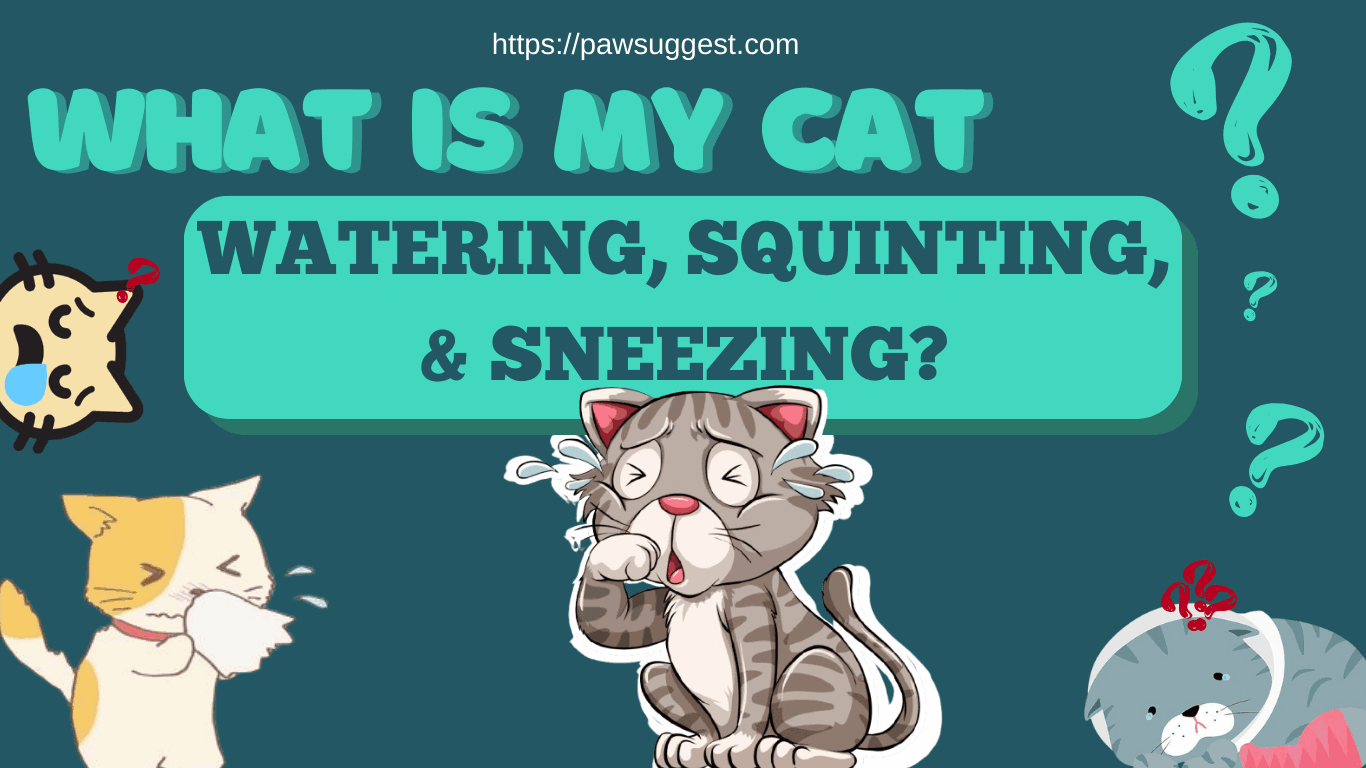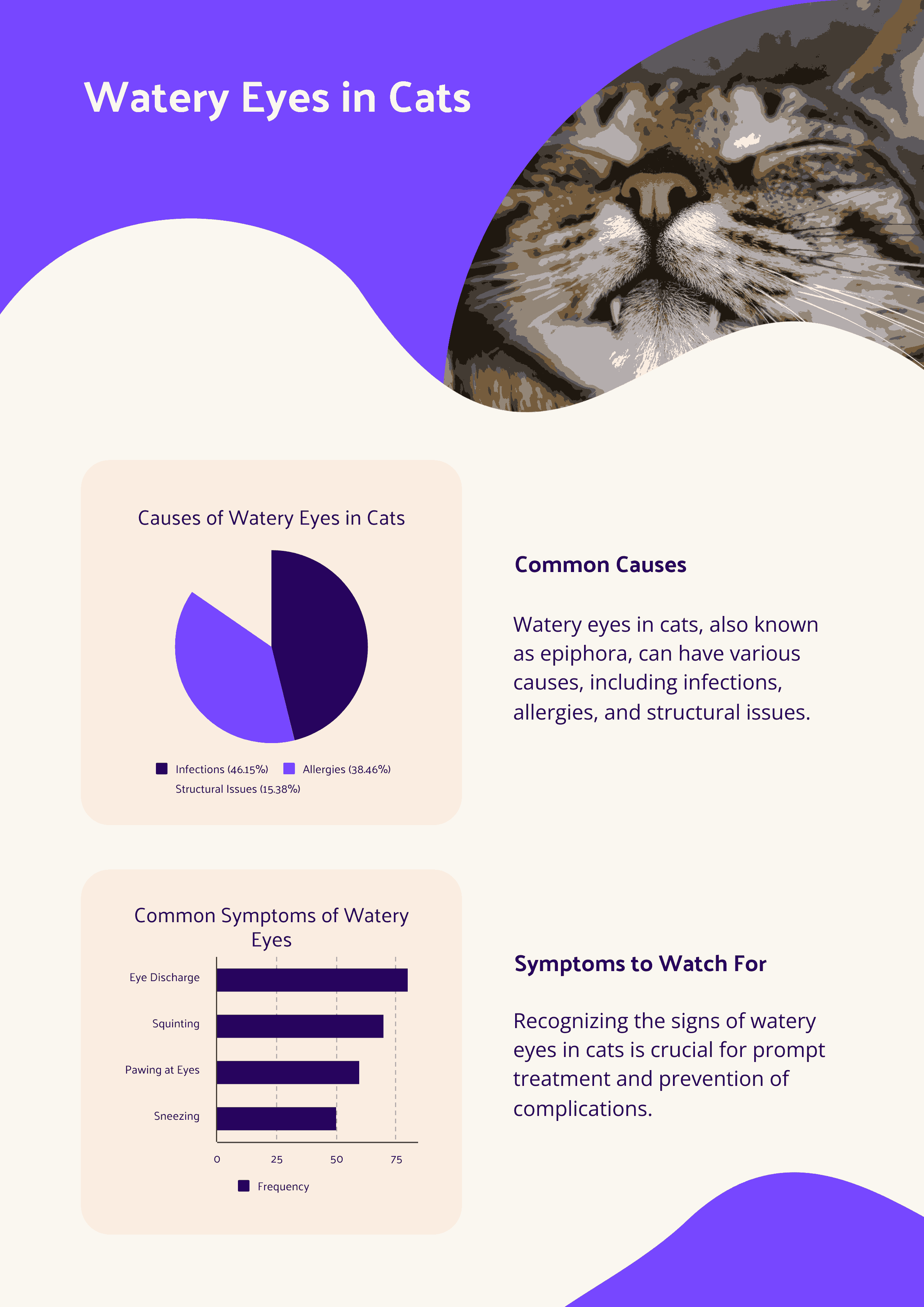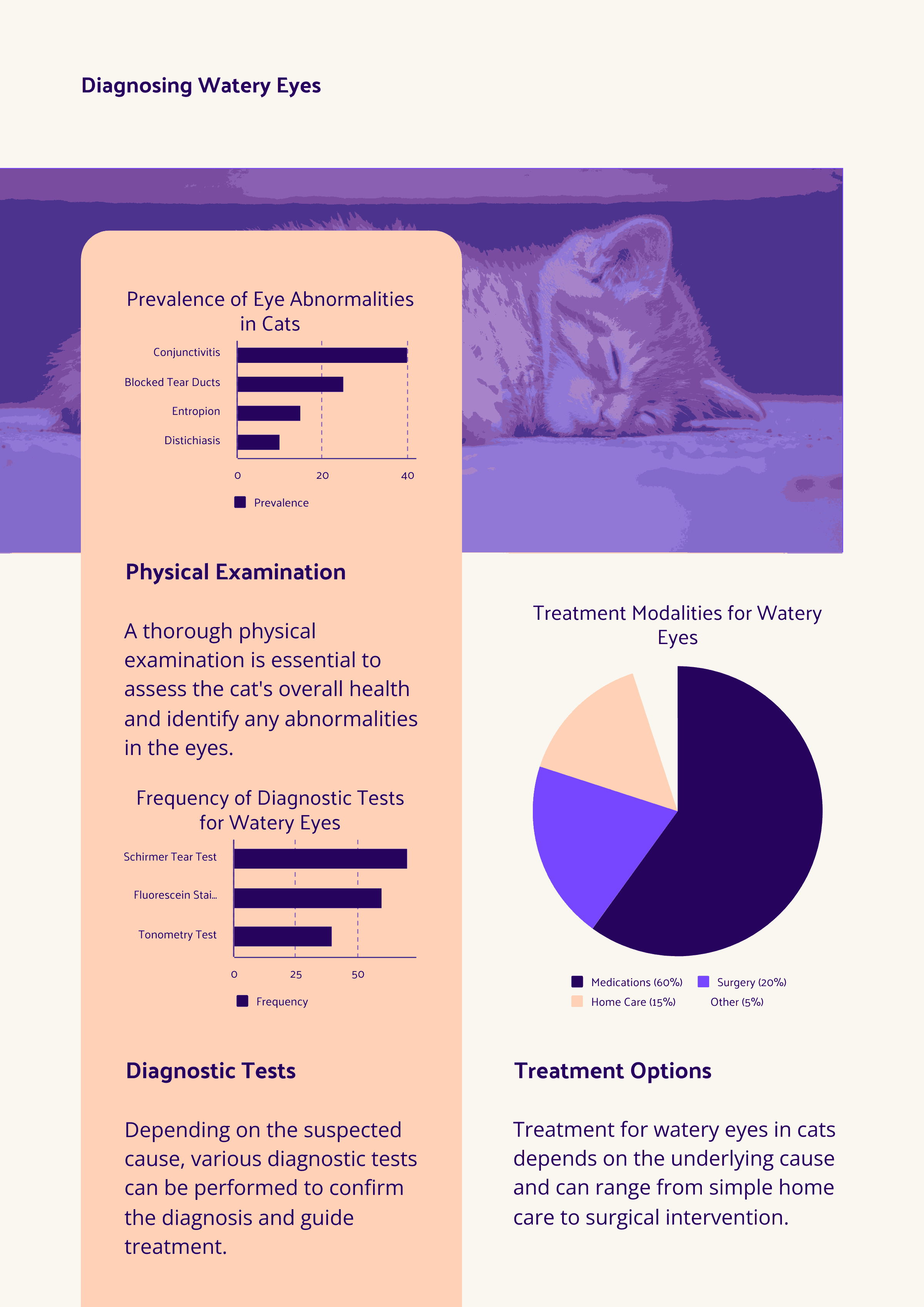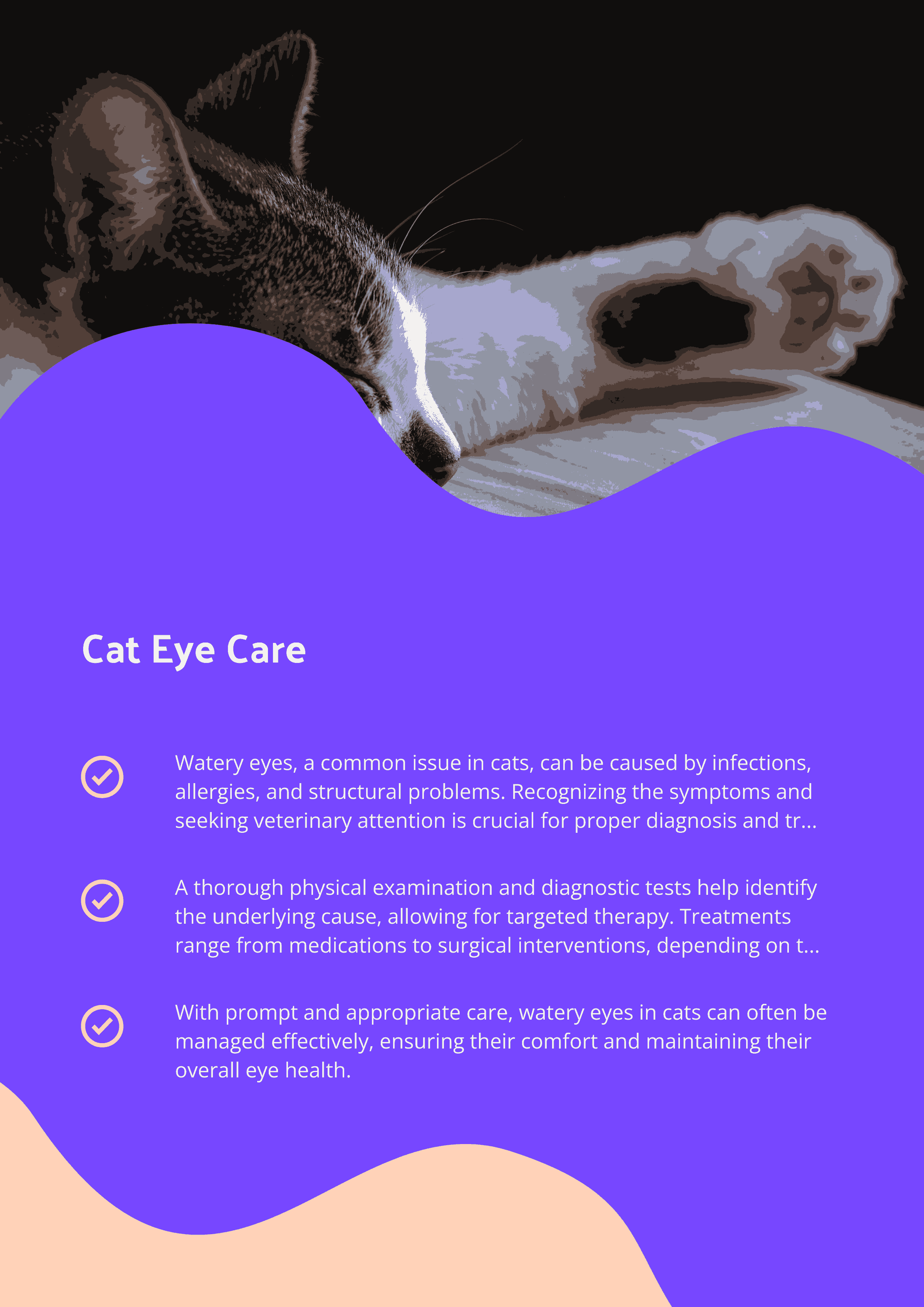If your cat’s eyes look teary or have a watery discharge, it might be a sign of epiphora. This tear film on the outer layer usually protects by washing away dirt and debris, but excessive tearing could indicate a health issue.
Commonly, such watery eyes are caused by an overflow of tears that don’t drain sufficiently. Sometimes, substances in the environment or even minor threats like chemicals and toxins can irritate a cat’s eyes.
If the problem persists, a checkup at the vet may help identify the cause and clear up any underlying threats to their health.

Why is My Cat Eye Watering, Squinting, & Sneezing?
Introduction to Watery Eyes in Cats
Epiphora, or watery eyes, is defined in veterinary terms as an abnormal overflow of tears often seen in brachycephalic breeds like Himalayans and Persians.
Due to congenital abnormalities, such as distichiasis or entropion, their eyelids or eyelashes may turn inward, causing irritation and exposure of the eyeball to the outside world.

Causes of Watery Eyes in Cats
Learn about common causes of eye watering in cats, including viral infections, allergies, foreign objects, and more:
1. Viral Infections: Feline Herpesvirus & Upper Respiratory Issues
When a cat has a cold or fever, viruses like feline herpesvirus can cause watering, sneezing, and discharge. Vaccines help protect against these viruses and reduce flare-ups.
- Symptoms: Sneezing, watery discharge, red and inflamed eyes
- Risk: Cats without vaccination are more prone
2. Foreign Objects and Outdoor Hazards
Dirt, pollen, or a foreign object can irritate a cat’s eyes. Outdoor cats and short-faced breeds are more vulnerable as their eyes are less protected from environmental elements.
- Risk Factors: Short heads, bulging eyes, outdoor exposure
- Common Irritants: Dirt, pollen, small debris
3. Allergies: Environmental and Food-Related
Allergies to dust, pollen, or even certain foods can cause eye watering. Common signs include sneezing, red eyes, and itchiness. HEPA filters and avoiding perfumes can help.
- Triggers: Dust, cleaning products, pollen, specific foods
- Solutions: Use HEPA filters, limit allergens in home
4. Conjunctivitis and Bacterial Infections
Conjunctivitis, or pinkeye, is a common infection causing watery eyes and redness. Often, it’s contagious and triggered by bacteria or allergies. A veterinary exam may suggest antibiotic eyedrops.
5. Genetic Predispositions in Brachycephalic Breeds
Breeds with short faces like Persians or Himalayans are prone to eye watering due to structural features like small heads and flat noses. Genetic factors make them vulnerable to tear drainage issues.
6. Structural Deformities and Blocked Tear Ducts
In some cases, blocked tear ducts or structural deformities cause tear buildup. The nasolacrimal duct may fail to drain, leading to epiphora, or excessive tearing.
- Symptoms: Watery discharge, runny eyes, inflamed eyelids
- Treatment: Sometimes requires surgical intervention
7. Eye Trauma and Physical Injury
Injuries from fights, scratches, or accidents can damage the cornea and lead to watering. Cats involved in hit-by-car incidents often need a thorough veterinary exam to rule out fractures or ulcers.
8. Tumors and Serious Eye Conditions
Rarely, tumors like squamous cell carcinoma affect white-faced cats and cause watery eyes. Veterinarians may check for growths in severe cases, especially if ulcers or vision loss are present.
- Commonly Affected: White cats, older animals
- Treatment: Early diagnosis leads to better outcomes
9. Glaucoma and Increased Eye Pressure
Glaucoma causes pressure inside the eye, resulting in watering, cloudiness, and pain. This condition is often seen in older cats and requires immediate vet care to prevent blindness.
Symptoms of Eye Issues in Cats
Watery eyes in cats can indicate various health issues. Understanding the signs is essential for proper care. This guide covers key symptoms to watch for in your feline friend:
Eye Discharge and Redness
Watery eyes can lead to discharge that might be clear, yellow, or green. This often means there’s an infection or allergy. You might also notice redness around the eyes, which indicates irritation.
Squinting and Blinking
When a cat is squinting or blinking too much, it can be a sign of ocular irritation. This may happen if there’s a foreign body in the eye or a blocked nasolacrimal duct. Tears can overflow, making it look like the cat is crying.
Pawing at the Eyes
If your cat is pawing at their eyes, they might be trying to relieve itchiness or discomfort. This behavior can mean they have an allergy or infection. Fever in cats can also increase discomfort, leading to more pawing.
Sneezing and Nose Discharge
Sneezing or nasal discharge often goes hand in hand with watery eyes. These symptoms could indicate an upper respiratory infection or a feline cold. If the symptoms worsen, it’s best to see your vet.
Pain and Swelling
If you notice swelling around the eyes or bulging, this could indicate a more serious issue like glaucoma. Emergency veterinary care is necessary if these symptoms occur suddenly or if the eyesight seems affected.
Fur Loss and Staining
Excessive tearing can lead to fur loss around the eyes. Reddish-brown staining on the fur is common in white-haired felines. Keeping your cat’s face clean can help prevent this problem.
When to Take Cat to Vet for Watery Eyes?
If your cat has watery eyes for longer than 24 hours, it may be time for a veterinary appointment. Keep an eye on any change in their symptoms. If they seem happy but have mild issues, you can monitor them at home.
However, if your cat shows signs like red or squinting eyes, or if they are hiding and acting sick, call the vet for advice. If they are pawing at their eyes, acting blind, or if you see evidence of trauma or a foreign object, take your cat in immediately.
It’s always better to be safe than sorry. If you’re worried, don’t hesitate to call your vet. Quick action can help relieve discomfort and prevent serious conditions that could lead to blindness in your feline companion.

Diagnosis of Watery Eyes in Cats
When your cat has watery eyes, it’s important to gather information about their medical history and behavior. This helps the veterinarian to make an accurate diagnosis. They will focus on identifying the underlying cause of the watery eyes through various diagnostic tests.
- A physical examination will be performed to check the eyes closely.
- An allergy test may be conducted to rule out any allergens.
- A fluorescein stain test will help identify any trauma to the eyeball.
The veterinarian may also use additional tests, such as:
- The Schirmer tear test to measure tear levels.
- A tonometry test to check intraocular pressure for glaucoma.
- Imaging tests like radiographs, MRI, or CT scans to look for internal abnormalities.
If your cat has recurrent episodes of watery eyes, the veterinarian might test for infectious causes like feline herpesvirus. This involves swabbing the eyelids, nose, or throat to collect samples for laboratory analysis.
If you notice your cat has watery eyes, it’s best to take them to the vet to ensure they receive the proper care. This will help avoid potential complications and keep your feline companion healthy.
Notable points:
- Monitor for other symptoms, such as squinting or pawing at the eyes.
- Schedule regular vet visits to ensure their health.

Cat Eye Watering Treatment
When treating watery eyes in cats, it’s important to find the underlying cause. Many cats, like those with a small cat head and facial conformation such as Himalayans, may experience a condition called epiphora. This can lead to excessive tearing.
- Use clean, gentle wipes to clear tears daily.
- Apply topical antibiotics like oxytetracycline if there are infections.
- For viral infections, antivirals such as idoxuridine might be needed.
If a scared cat shows signs of upper respiratory issues, it could result in nasal discharge. Oral antibiotics, such as doxycycline and azithromycin, can help clear up the infection. Additionally, eyelid abnormalities or abnormal eyelashes, like ectopic cilia, may require surgery.
- Cryosurgery can stop hair follicle regrowth.
- If the nasolacrimal duct is blocked, a veterinarian can flush it with saline.
- Consider using a buster collar to prevent your cat from rubbing their eyes and worsening the situation.
Note:
- Medications may include anti-inflammatories for pain relief.
- Surgical repair may be necessary for conditions like Entropion or distichiasis.
Final Thoughts
The recovery process for cat’s eye watering varies based on the cause but generally includes:
- Veterinary Check-Up: A visit to the vet to diagnose the underlying cause is crucial.
- Medications: Treatments may include topical antibiotics or oral medications to manage infections and reduce inflammation.
- Home Care: Use gentle wipes and possibly a buster collar to prevent further irritation.
- Surgery: In cases of structural issues, surgical repair may be necessary for full recovery.
FAQs
Why is my cat’s eye watering and squinting and sneezing?
If your cat has watery eyes, squinting, and sneezing, they may have symptoms like a human cold, such as a runny nose or teary eyes. These signs suggest your feline friend might be suffering from a cat cold or upper respiratory infection.
What can I give my cat for sneezing and watery eyes?
To help your cat feel better with a cold, try running a humidifier or vaporizer to increase humidity in the house. For a stuffy nose, use a warm, damp cloth to gently wipe it, and cleanse their watery eyes with a saline solution on gauze pads.
How do I treat my cat’s eye infection at home?
Using a warm compress is an effective and gentle method to provide relief for cats suffering from minor eye infections. It can help reduce inflammation, alleviate pain, and promote drainage of any accumulated discharge.
How do you treat a cat with one eye closed and watery eyes?
Medications are commonly prescribed based on the specific issue. Antihistamines can manage allergies, topical antibiotics help treat bacterial infections, and pain relief is provided for conditions causing discomfort; anti-inflammatories can also address inflammation.

